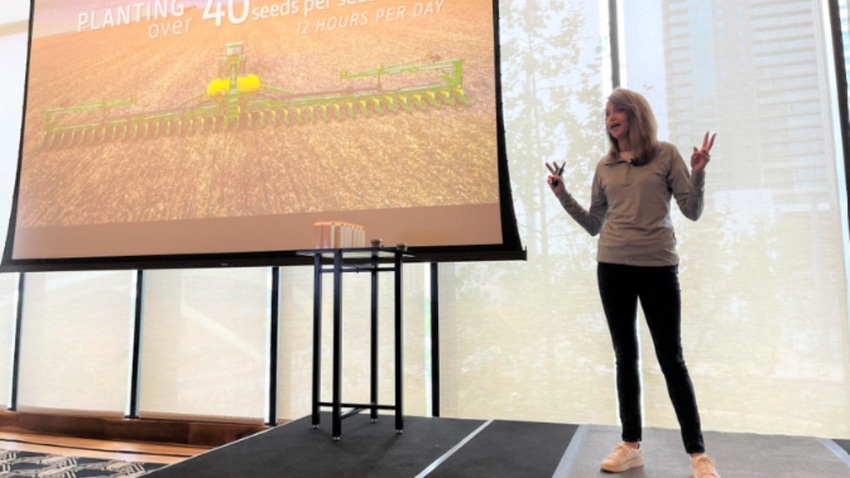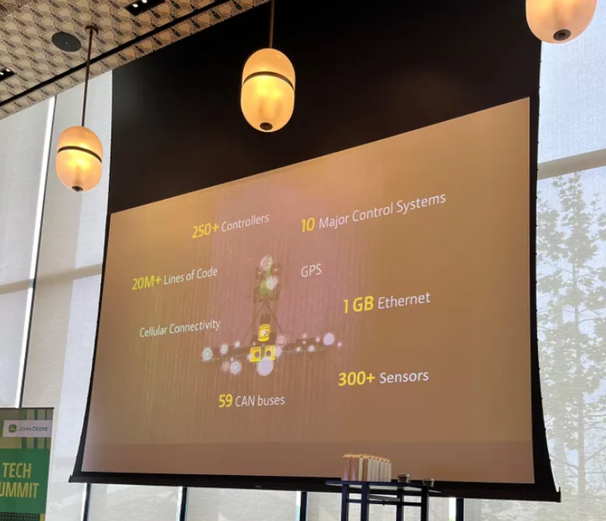John Deere Takes Seed Planting to a New Level
Fertilizer is placed on each seed as they are shot into the ground at high speed

At a Glance
- John Deere is taking its sensing technology down to the plant seed level.
- Deere's new technology lets the fertilizer spray only hit seeds rather than be broadly dispersed.
John Deere is taking its sensing technology down to the plant seed level.
It used to be that as seeds were being planted, albeit rapidly by Deere’s automated seeding technology, a constant spray of fertilizer could hit them on the way from the seeding machinery into the ground.
Each seeding device can run at a rate of shooting 20 to 40 seeds per second as the seeding machinery pulled by a tractor moves along. That seeding speed is per device, and there could be 24 such devices as part of the overall seeding mechanism.
The major change here is that Deere now has developed technology so that the fertilizer spray only hits the seeds rather than being a steady spray.
The new advanced seeding-fertilizer capability is facilitated by sophisticated and precise-tracking technologies.

“With the advancements of technology with AI, we can put sensors and cameras in places no eyes can be and be reactive in milliseconds,” said Nancy Post, vice president of embedded software and solutions at John Deere. “No person can do that.”
She was speaking at the John Deere Tech Summit, a three-day private event for media and tech influencers held in Austin.
“There's a lot that goes into figuring out how to optimize seed placement.”
Deere’s system for fertilizing each seed as it flies through the system is called Exact Shot. Rather than a steady stream of fertilizer hitting the seeds as they fly by, the system pulses rapidly, hitting each seed with fertilizer and pausing until the next seed passes. The action is so rapid it cannot be discerned without seeing it in slow motion.
“We're placing fertilizer directly on the seed,” said Post. “Putting that fertilizer as it has been traditionally done in between the seeds does not do a lot for the seed itself, so we are timing the placement of the seed and the fertilizer at exactly where we started running at 10 miles an hour. Before that, it was people using random planting at around five miles an hour. With this system, we have more than a 60% reduction in fertilizer.”
The seeding-fertilizer system is just one part of the technological process in the overall Deere approach to tech-enabled farming.
With constant connectivity of the Deere equipment, the farmer can track what areas were seeded to avoid duplication.
“As we are going through the field, we are logging the information in real time and sending it out to the cloud, to make each and every pass through the field more informed than the last,” said Post.
As the seeder moves along, it first digs a precise trench for the seed to be planted.
While the farming machinery may look totally manual as observed from the outside, the technological wizardry is hard at work behind the scenes.
The system comprises more than 300 sensors, 10 major control systems, 20 million lines of code along with GPS and gigabit internet speed.
Farming is being transformed as it becomes more tech-driven.
This is the second in a series on how John Deere is taking high-tech farming to the next level.
This story first appeared in our sister publication, IoT World Today. To subscribe to the IoT World Today newsletter, click here.
About the Author(s)
You May Also Like


.jpg?width=700&auto=webp&quality=80&disable=upscale)
.jpg?width=700&auto=webp&quality=80&disable=upscale)
.jpg?width=700&auto=webp&quality=80&disable=upscale)
.jpg?width=300&auto=webp&quality=80&disable=upscale)

.jpg?width=300&auto=webp&quality=80&disable=upscale)
.jpg?width=300&auto=webp&quality=80&disable=upscale)
.jpg?width=300&auto=webp&quality=80&disable=upscale)